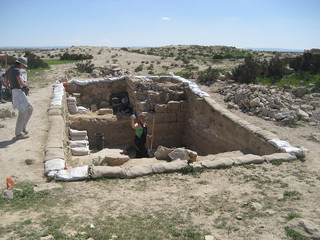Elusa. Vorbericht zur siebten Grabungskampagne. KuBA 13 (in Vorbereitung). (zusammen mit M. Heinzelmann, T. Erickson-Gini und F. Jordan)
Elusa. Arbeitsbericht zu den Survey-Kampagnen 2022 and 2023. KuBA 13 (in Vorbereitung) (zusammen mit M. Heinzelmann und T. Erickson-Gini)
Elusa – From Nabatean Trading Post to Late Antique Desert Metropolis. Results of the 2015-2020 Seasons, Archäologischer Anzeiger 2022/1, 236-297. (Auch Online verfügbar); zusammen mit M. Heinzelmann, D. Wozniok, A. Schröder, F. Jordan, T. Erickson-Gini, M. Kühn, D. Langgut und S. Lehnig)
Haluza. Preliminary Report, Hadashot Arkheologiyot 134, 2022 (Online-Artikel; zusammen mit F. Jordan, T. Erickson-Gini und M. Heinzelmann)
Elusa. Arbeitsbericht zur Survey-Kampagne 2021, KuBA 11/12, 2021/22, 155-164. (zusammen mit D. Wozniok, A. Schröder, T.Erickson-Gini und M. Heinzelmann)
Elusa. Vorbericht zur sechsten Grabungskampagne 2022, KuBA 11/12, 2021/22, 165-194. (zusammen mit M. Heinzelmann, F. Jordan, L. Heinze, D. Wozniok und T. Erickson-Gini)
Elusa – ein bislang unbeachtetes Landwirtschaftssystem im Negev? Zwischenbericht zum Elusa-Umlandsurvey (2018 bis 2020), Kölner und Bonner Archaeologica 9/10 (2019/20) 141-160. (zusammen mit M. Heinzelmann, D. Wozniok und T. Erickson-Gini)
Elusa – Urban Development and Economy of a City in the Desert. In: A. Lichtenberger – O. Tal – Z. Weiss (eds.), Judaea/Palaestina and Arabia: Cities and Hinterlands in Roman and Byzantine Times (Heidelberg 2019) 147-160. (zusammen mit M. Heinzelmann, T. Erickson-Gini und D. Wozniok)
Elusa (I). Vorbericht zur Grabungs- und Surveykampagne 2019, KuBA 8, 2018, 125-144. (zusammen mit F. Jordan, T. Erickson-Gini und M. Heinzelmann)
Elusa. Vorbericht zu den Kampagnen 2017 und 2018, KuBA 7, 2017, 99-128. (zusammen mit M. Heinzelmann, T. Erickson-Gini und F. Jordan)
Erheben, Erstellen und Aufbereitung eines Geländemodelles in Elusa (Israel). KuBA 5, 2015, 268-276. (zusammen mit Ch. Stollwerk, A. Schröder und V. Kannengießer)

